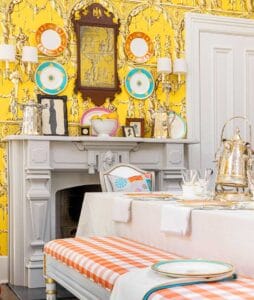 A beautifully preserved country mansion proves that history belongs to the bold.
A beautifully preserved country mansion proves that history belongs to the bold.
This story originally appeared in the March/April 2022 issue of Missouri Life magazine.
Henry Blosser was three generations removed from his Swiss ancestors, but that didn’t stop the nineteenth-century land speculator from celebrating his heritage when he and his wife, Sarah, built their dream home in 1878 on 640 acres near the town of Malta Bend. Decorative trim and shutters and a roof embellished with stripes of red, blue, green, and black invoked the spirit of a Swiss chalet, even though the architecture was Second Empire and so very French.
The Blosser family came and went, and time leeched away the color and life from the home. When Dr. Arthur Elman and his wife, Carolyn, visited the house for the first time in 2014, it had been neglected, vandalized, and placed on Missouri Preservation’s endangered properties list.
The fertile cropland it was sitting on was more valuable than the house itself, and it was destined for demolition—until the Elmans stepped up to save both the house and the equally impressive barn. Art and Carolyn hired Kelee Katillac, a noted interior designer with a track record of reinvigorating historic properties. Kelee and her team of preservation contractors and consultants were hired to preserve the buildings to the stringent standards required of a property on the National Register of Historic Places, while making them comfortable for modern living and reflective of the Elmans’ personal tastes and interests.

—Photos by Aaron Leimkuehler
To accomplish that, Kelee relied heavily on color.
“The affinity for personal color is a historical tradition,” Kelee says. “Many modern viewers are unfamiliar with the bold use of color in our founding fathers’ great houses. For example, George Washington and Thomas Jefferson were known for their differences in politics, and the competition between them seemed to become visible as each designed their home as a signifier of taste, personal style, and as a physical manifestation of allegiances. In his dining room, Washington enameled the walls in a bold emerald green and deployed English furniture for his guests. Some could theorize it signaled a complicated resonance with monarchy. Jefferson, whose time in Paris led to an admiration for French style, called on a stimulating chrome yellow for the dining room, dramatically setting the stage for his intellectual salons and dinner parties.”
Kelee allowed the stately historic homes of Mount Vernon, Monticello, and others to inform her design choices, but she didn’t get mired in the past. The Blosser House design features Kelee’s fresh colorations of historic wallpaper patterns, vivid contrasts, and modern furnishings in harmony with centuries-old antiques.
The project, completed in early 2020, has gained international accolades for design, and the Elmans were honored with Missouri Preservation’s prestigious McReynolds Award for their commitment to saving the imperiled house and barn. The property, redubbed the Blosser-Elman Museum of Decorative Arts, will open for tours when COVID concerns subside.
Kelee describes the lavish use of color as an indicator of courageous assurance, a quality shared by the Blossers and the Elmans. “They aligned with each other and this similar use of color,” she says. “Color and pattern become part of the narrative thread that connects that past to the present owners of the house.”

 A beautifully preserved country mansion proves that history belongs to the bold.
A beautifully preserved country mansion proves that history belongs to the bold.






